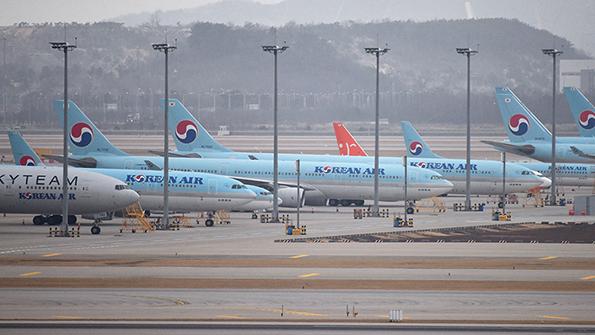
With the resumption of domestic travel well underway in many Asia-Pacific markets, attention is now shifting to reopening international links within the region. This is a much more complex proposition, and some governments are taking the first steps toward establishing a framework for international travel in a post-COVID-19 world.
Air travel virtually ground to a halt across the Asia-Pacific region in the wake of the coronavirus outbreak. The few international flights offered have mostly been focused on cargo and repatriation, with most foreign travelers blocked by border closures or dissuaded by 14-day quarantine requirements. Most airlines have cut their overseas networks to a bare minimum and are only operating limited frequencies on a handful of routes.
- China, South Korea have established essential travel corridors
- Other countries are also looking to restore international links
However, many countries in the region have made good progress in controlling COVID-19, prompting them to restart scheduled airline operations to help spur economic recovery. The conventional wisdom is that domestic service will rebound first in most markets, followed by short-haul international, then finally long-haul routes.
Discussions have begun between some Asia-Pacific governments about easing border and quarantine restrictions to allow essential travel. These will initially be bilateral arrangements between countries so procedures and safeguards can be rigorously monitored. Such programs will likely expand to multilateral agreements in the longer term, and could also pave the way for broader deals that would include nonessential travel.
China and South Korea are among the first movers. They were hit early by the pandemic, but have also rebounded sooner. The two countries agreed to establish “travel corridors” to allow some business traffic between Seoul and 10 Chinese regions, including the key market of Shanghai.
While restrictions have been eased by China and South Korea for these services, there are still extra requirements in place. Approved business travelers must be tested before they leave and after arriving, and are subject to a shortened two-day quarantine.
The travel corridors arrangement began on May 1. Korean Air told Aviation Week it is difficult to gauge the effect on demand, as the carrier is currently only flying one of its routes to China. However, the airline is hoping the initiative will boost business travel demand in the long term.
Restoring these traffic flows is important for both countries. China-South Korea was ranked ninth among all international markets in terms of seat capacity a year ago, according to data from the CAPA – Centre for Aviation and OAG. In mid-January—before the COVID-19 restrictions hit—it was ranked sixth globally.
However, broadening air links between South Korea and China remains complicated. Both Korean Air and Asiana Airlines intended to resume multiple routes to China in June, but those plans have been put on hold because of the Chinese government’s restrictions on new routes.
Korean Air is currently operating just one of its 29 mainland China routes—to Shenyang. The airline said in May that it planned to add six more China routes to its June schedule, in addition to resuming about a dozen international routes to other countries. The latest update of the June schedule includes all of the route resumptions except those planned for China.
The carrier now intends to restore four routes to mainland China in July, with flights from Seoul to Beijing, Shanghai, Guangzhou and Qingdao.
Likewise, Asiana planned to restart 11 mainland China routes in June, but none of these are listed on its schedule yet. Asiana is currently only operating sporadic flights on one of its 27 regular mainland China routes.
This situation highlights that resuming international services will be a shifting target for many Asian airlines and markets. Plans will often have to be changed at short notice if governments do not open borders as expected or if new spikes in coronavirus cases arise.
China is holding talks with other Asian countries with a view to forming arrangements similar to its deal with South Korea. The governments of China and Singapore have agreed to establish “fast lanes” this month to “facilitate essential travel for business and official purposes,” according to a joint statement. This will initially apply to travel between Singapore and six municipalities or provinces in mainland China, and the two parties say they will gradually expand the program to the other Chinese provinces.
Singapore is also discussing the same type of bilateral arrangements with countries including Australia, New Zealand and South Korea. In a promising sign for a multilateral approach, these countries are among the signatories of a joint statement committing to develop procedures for essential cross-border travel and supply links.
Meanwhile, Australia and New Zealand are looking at establishing a “travel bubble” that would go much further than the essential travel corridors. The two nations want flight links between them for leisure and business travelers with no necessity for quarantine, although there could still be some other requirements.
Talks between the two countries are being watched closely, as this could be the first substantial reopening of an Asia-Pacific international market since the COVID-19 closures. Qantas CEO Alan Joyce says if it is successful, this could be a template to open other international markets one-by-one.
A joint working group has been formed to examine how the travel bubble would be implemented. The group comprises industry and government representatives from both Australia and New Zealand, and is expected to present its findings to ministers this month. There are various estimates as to when the arrangement could begin, with some officials saying as early as July and others suggesting September.
The leaders of both countries are eager to proceed with the working group plan. The travel and tourism industries are pushing hard for the arrangement, as they have been battered by the loss of business related to the pandemic. New Zealand is the leading outbound market for Australian travelers, and New Zealand also provides Australia’s second-largest inbound market after China.
Another important development has seen some countries remove prohibitions on international connecting flights. Singapore and Hong Kong both decided to allow transit passengers through their airports starting this month. Foreign travelers will generally still not be allowed to end their journeys in Hong Kong or Singapore, but they will be able to connect there.
This is an important step for both Cathay Pacific and Singapore Airlines. With no domestic networks, their business strategies rely heavily on connecting traffic flows between overseas markets, such as Western Europe and Australasia. While many of the airlines’ major overseas markets remain closed, allowing transit flights means they can respond quickly when travel from these countries resumes. It will also help prevent other connecting hubs in Asia and elsewhere from gaining a competitive advantage.
But again, some countries remain excluded. Cathay Pacific noted that transit flights to and from mainland China will still not be available.
